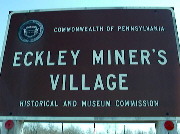

Eckley is one of hundreds of company mining towns or "patches" built in the anthracite region during the nineteenth century.
In 1854, the mining firm of Sharpe, Leisenring, and Company, later known as Sharpe, Weiss and Company, leased land from the Tench Coxe Estate of Philadelphia and began work on Council Ridge Colliery and the Village of Eckley. The village, built near the colliery where coal was mined and processed, provided housing for miners and their families. Its stores, schools and churches supplied the economic, education, and religious needs to the villagers. By owning the village, the company had greater control over the lives of their workers.
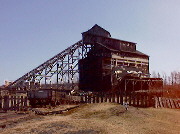 After 1875, when the Sharpe, Weiss lease expired, the Coxe family either operated the colliery themselves or leased it to other coal companies. During
this period many changes took place. To Eckley came a succession of immigrant groups seeking economic opportunities and regilious or political freedom.
English, Welsh, and German miners were supplmented by Irish immigrants and then by southern and eastern Europeans. these groups formed an ethnic mosiac
typical of the anthracite region.
After 1875, when the Sharpe, Weiss lease expired, the Coxe family either operated the colliery themselves or leased it to other coal companies. During
this period many changes took place. To Eckley came a succession of immigrant groups seeking economic opportunities and regilious or political freedom.
English, Welsh, and German miners were supplmented by Irish immigrants and then by southern and eastern Europeans. these groups formed an ethnic mosiac
typical of the anthracite region.
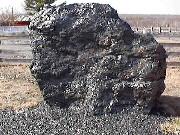 Strip mining, begun in 1890, gradually replaced underground mining. Steam shovels stripped away the part around Eckley as well as part of the village.
The work force at the Colliery and the population of Eckley gradually declined. From a population which numbered over one hundred in 1870, only nineteen remain.
Strip mining, begun in 1890, gradually replaced underground mining. Steam shovels stripped away the part around Eckley as well as part of the village.
The work force at the Colliery and the population of Eckley gradually declined. From a population which numbered over one hundred in 1870, only nineteen remain.
During the liquidation of the Tench Coxe Estate, Eckley was sold to coal company owner George Huss. The village was seperated from the mining operation in 1969 when the Huss Coal Company sold Eckley to the Anthracite Historical Site Musuem, Inc., a group of Hazleton are businessmen. They deeded it to the Commonwealth of Pennsylvania in 1971.
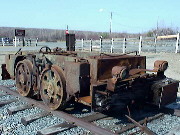 The coal first exploited by Sharpe, Weiss and Company continues to be mined at the
outskirts of the village. The old Council Ridge Colliery is gone, but its village survives. A company town until its acquisition by the Pennsylvania
Historical Museum Commission, Eckley preserves a way of life which dominates the anthracite region for over 140 years.
The coal first exploited by Sharpe, Weiss and Company continues to be mined at the
outskirts of the village. The old Council Ridge Colliery is gone, but its village survives. A company town until its acquisition by the Pennsylvania
Historical Museum Commission, Eckley preserves a way of life which dominates the anthracite region for over 140 years.
1. Visitor's Center, The visitors Center introduces the village with an orientation video and exhibits on the history of Eckley and on the life in mining towns throughout the anthracite region. The homelife of the miner, his wife, and their children is the focus.
2. Picnic Area, There is a small picnic area located behind the Visitor's Center.
3. Immaculated Conception Church Rectory, 1861. This gothic revival house served as the residence of the Eckley parish priests: Father Patrick J Noonan (1862-1868), Father John Mullen (1868-1869), and Father Michael Fallihee (1870-1902). After Father Fallihee moved from Eckley in 1902, the rectory became a private residence. Not open to the public.
4.The Church of the Immaculate Conception,
1861. This simple wooden church was built to serve Eckley's first Roman Catholics, primarly Irish.
The alter was consecrated on October 25 1861 by Bishop Wood of Philadelphia. At first the church was
a mission of St Joseph's Church, Laurytown, and was part of the Diocese of Philadelphia.Immaculate
Conception became a parrish church when Father Noonan was appointed as the first pastor in 1862;
he was assigned by Father Mullen. In 1867 it was placed in the newly created Diocese of Sctanon.
by 1930 the congregation of Immaculate Conception had declined. Its mission church, St. Anne's, at Woodside near Freeland was better attended. As a result, the Eckley church was supressed and St. Anne's became the parish church. Services were held irregularly in Eckley until early 1960's. Open to the public, with Guide.
5. Laborers' Double Dwelling, c.1854. The small double houses located at the eastern end
of the village were tenanted by unskilled laborers in the colliery. The houses are of simple frame and plank
construction and clapboard on the exterior and plastered on the interior. Each family had four rooms. A shallow stone
cellar provided storage space for food grown in backyard gardens. Under development.
6.Foundations of Double Dwellings, burned c. 1925.
7.Back or South Street Cottage, c. 1854. This double house is the only remaining house of its type on a street which one time had thirty two dwellings. Smaller in size than the laborers' houses on Main Street, it had only three rooms per family. Like the houses opposite it on Main street, it probably was tenanted by other unskilled laborers (The other buildings nearby, painted red, are modern reconstructions). Not open to the Public.
8.Miners Double Dwelling, c.1845. This house is slightly larger than the laborers' houses at the eastern end of town and may have been occupied by the first class or contract miners. The exterior red and black colors were typical of miners' housing in the region, red being an inexpensive paint pigment.
One half of the house shows furnishings typical of many towns about 1890. The other half of the interior shows furnishings of an established miner. Each family would have had four rooms - two upstairs and two downstairs. The second floor is not open for visitation. A summer kitchen stands behind the house. The summer kitchen was built later in order to make the home more comfortable. The stove was moved from the house to the summer kitchen in the spring, and back again in the fall. Eventually, the summer kitchen was attached to the house by a breezeway to create move living space. Open to the public, with guide.
9.Double Family Dwelling c.1875. Not indicated on Maps of Eckley prior to 1874, this house, and the seven others similar to it, differs in design and size from other double dwellings in the village. Skilled colliery workers would have occupied these larger four room double dwellings. Under development.
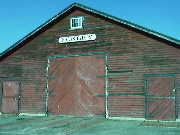
10. Mule Barn, 1968. The first one is located
near the general store. It was a prop for the "Molly McGuires" movie. The original has been reconstructed
at the west end of town, It is located near the Mine Owners Home, this picture is of the original
and is not opened to the public.
 11.Breaker, 1968. This movie prop stands near the site
of one of three original Council Ridge breakers. The exterior is similar in appearance to the wooden
breakers once found throughout the anthracite region.
11.Breaker, 1968. This movie prop stands near the site
of one of three original Council Ridge breakers. The exterior is similar in appearance to the wooden
breakers once found throughout the anthracite region.
Lump coal from the mine was cleaned and sized in the breaker. Large rollers with projecting teeth broke the large lumps into marketable sizes. From the rollers, the coal passed through a series of metal screens which separated it into uniform sizes, each for a different use. The sized anthracite traveled down chutes manned by the breaker boys who picked out pieces of slate and rock. Cleaned and sorted coal was loaded into railroad cars at the bottom of the breaker. Not open to the public.
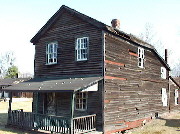
12. Single Family Dwelling, 1854. These large single houses were inhabited by mine "bosses"
- the colliery superintendents and foremen. Not opened to the public.
13.Presbyterian Church, 1859; removed c. 1925. In November 1857, Reverend Jonathan Ormond was appointed pastor of the
Presbyterian congregation in Eckley, then meeting in the village schoolhouse. A small church was built in 1859. Mr Albert Wintereck,
a Prussian, also served in the Presbyterian church to help minister to the German-speaking population of Eckley. By 1920, Eckley's
population had declined; the church could no longer be maintained and was removed.
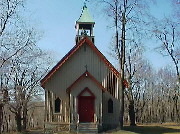
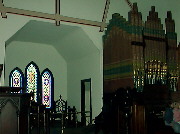 14.St James Protestant Episcopal Church, 1859. Mine operators
Richard Sharpe and Francis Weiss were leaders in the formation of the Episcopal church in Eckley. Mr. Sharpe's brother-in-law, the
reverend Peter Russell, was the first rector. Like the Presbyterian church, St. James congregation declined in the twentieth century and, in 1938
the structure was removed. A nearby identical sister church, St. Paul's Protestant Episcopal church of White haven was moved to this site in 1974. Open to public
with guide.
14.St James Protestant Episcopal Church, 1859. Mine operators
Richard Sharpe and Francis Weiss were leaders in the formation of the Episcopal church in Eckley. Mr. Sharpe's brother-in-law, the
reverend Peter Russell, was the first rector. Like the Presbyterian church, St. James congregation declined in the twentieth century and, in 1938
the structure was removed. A nearby identical sister church, St. Paul's Protestant Episcopal church of White haven was moved to this site in 1974. Open to public
with guide.
14.Foundation of Eckley Hotel, c.1857; burned c. 1925. The Eckley Hotel, first managed by Mrs. Sophia Houser, contained the only barroom in the village. It was the site of celebrations, oyster suppers, and St. Patrick's Day banquets. In later years the building was used only as a boarding house.
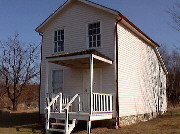 15.Doctor's Office, c.1855.
Eckley's first company doctor, George Wentz, treated mining accident victims and
other villagers too ill to be cured with home remedies. In later years the company doctor was replaced by a resident nurse. Serious injuries or illnesses were
treated in the Drifton Hospital or by doctors in Freeland, some of whom paid regular visits to the village. Open to the public with guide.
15.Doctor's Office, c.1855.
Eckley's first company doctor, George Wentz, treated mining accident victims and
other villagers too ill to be cured with home remedies. In later years the company doctor was replaced by a resident nurse. Serious injuries or illnesses were
treated in the Drifton Hospital or by doctors in Freeland, some of whom paid regular visits to the village. Open to the public with guide.
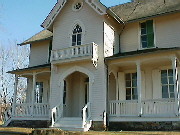 16.Mine Owner's House, c. 1861.The mine owners lived in the largest, most fashionable houses located away
from the miners' cottages and the colliery buildings. Richard Sharpe's gothic revival house was the last constructed and largest of the residences. The home
apparently was comfortably furnished and, in addition to the Sharpe family, housed three servant girls and gardener. Under
Development.
16.Mine Owner's House, c. 1861.The mine owners lived in the largest, most fashionable houses located away
from the miners' cottages and the colliery buildings. Richard Sharpe's gothic revival house was the last constructed and largest of the residences. The home
apparently was comfortably furnished and, in addition to the Sharpe family, housed three servant girls and gardener. Under
Development.
The American branch of the family of Coxe. The first ancestor of the coxe family connected with America was Dr. Daniel Coxe, who was physician to the Queen of Charles II., of England, and also to Queen Anne. He was be purchase from the King principal proprietary of soil of West Jersey, and sole proprietor of the government, he having held the office of governor to him and his descendants forever. At the request of Queen Anne he surrendered the government to the crown, retaining the other proprietary rights. This history incident may be consulted in the old folio edition of the Laws of New Jersey. A member of the Coxe family was always appointed by the crown, while there was a resident member in the province, as a member of the royal council of New Jersey until the Revolution. Governor Coxe was called the great proprietor. Here's an account of his son, Daniel Coxe, the first ancestor who resided in America. Dr. Coxe was also proprietor of the extensive province of Carolina.
Col. Daniel Coxe, entitled the "History of Carolina". The writer had the pleasure of examining a copy
of this book in the library of Hon. Eckley B Coxe of Drifton. Dr. Coxe was also a large proprietor
of land in Pennsylvania, and in other of the American colonies. To his eldest son, Col. Daniel Coxe, he gave all
his American Possessions, the gentleman that is mentioned as the first resident above. He arrived here in 1702;
inter-married with Sarah, the only child of John Eckley, Judge of the supreme court of Pennsylvania, and lefted
issue among others, William Coxe, who married Mary, daughter of Tench Francis, Attorney General of province of
Pennsylvania. Trench Coxe was the son of William and Mary Coxe; 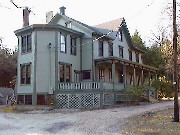 born in Philadelphia, May 22, 1755, died July 17,
1824. Summarized the genealogy of the Coxe family is: Dr. Daniel Coxe of London, Governor of West Jersey etc., born in 1640
died in 1730; His son Col. Daniel Coxe, born 1663; died Apr 25 1834; His son William Coxe born May 8 1723; died Oct 11 1801;
His son Hon Tench Coxe, born May 22 1755, died Jul 17 1824; his son Hon. Charles S Coxe, of Philadelphia born Jul 31 1791,
died Nov 19 1879;
born in Philadelphia, May 22, 1755, died July 17,
1824. Summarized the genealogy of the Coxe family is: Dr. Daniel Coxe of London, Governor of West Jersey etc., born in 1640
died in 1730; His son Col. Daniel Coxe, born 1663; died Apr 25 1834; His son William Coxe born May 8 1723; died Oct 11 1801;
His son Hon Tench Coxe, born May 22 1755, died Jul 17 1824; his son Hon. Charles S Coxe, of Philadelphia born Jul 31 1791,
died Nov 19 1879;
This, as briefly as possible, is something of the ancestry of Hon. Eckley B Coxe the head of the house of Coxe, Bros. & Co., of Drifton, one of the largest coal producers of any house in the world. A word more here as to the family name of Eckley, and the romantic manner in which it came into such close connection with that of the Coxe, may well be produced.
Sarah Eckley, of whose match ( as quoted by the annalist) one of Margaret Preston, evidently a member of the Society of Friends, writes in 1707, as follows: "The news of Sarah Eckley's marriage is both sorrowful and surprising, with one Col. Coxe, a fine, flaunting gentleman, said to be worth a great deal of money, a great inducement, it is said on her side. Her sister Trent was suppose to have promoted the match. her other friends were ignorant of the match. It took place in the absence of her Uncle and Aunt Hill, between 2 and 3 in the morning, on the Jersey side, under a tree by fire-light. They have since proselyted her and decked her in finery."
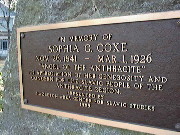 Eckley B Coxe married Sophia _____. They lived in Drifton, Pa in a house that
still stands today. The house is now open to the public by appointment. On September 17 1887, the miners went on strike at Eckley. They wanted
more wages. As the company owned the houses in Drifton & Eckley it almost certain they would lose their homes too. The miners did not trust
any of the Coxe family except for one, Sophia. A rumor had gained some credence that if the dispute between the Coxe's and the Miner's is not
settled Mrs. Coxe will purchase the mines and operate them herself.
Eckley B Coxe married Sophia _____. They lived in Drifton, Pa in a house that
still stands today. The house is now open to the public by appointment. On September 17 1887, the miners went on strike at Eckley. They wanted
more wages. As the company owned the houses in Drifton & Eckley it almost certain they would lose their homes too. The miners did not trust
any of the Coxe family except for one, Sophia. A rumor had gained some credence that if the dispute between the Coxe's and the Miner's is not
settled Mrs. Coxe will purchase the mines and operate them herself.
The miners cite in confirmation of this rather improbable story that some years since when the people were refused the privilege of picking coal from the culm dumps, Mrs. Coxe bought the dumps and posted notice that all persons might pick coal from them freely.
Other Links to Eckley:
1870/1880 Eckley Census you may find some of these names on the following census also.
1870 Eckley/Upper Lehigh Census
©1997-2016 by Mary Ann Lubinsky for the PAGenWeb
Project, and by Individual Contributors
Mary
Ann Lubinsky
County Coordinator
Back To Luzerne Genweb